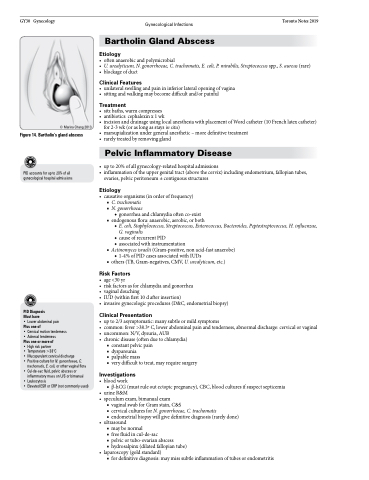Page 516 - TNFlipTest
P. 516
GY30 Gynecology
Gynecological Infections Toronto Notes 2019 Bartholin Gland Abscess
Etiology
• oftenanaerobicandpolymicrobial
• U. urealyticum, N. gonorrhoeae, C. trachomatis, E. coli, P. mirabilis, Streptococcus spp., S. aureus (rare) • blockageofduct
Clinical Features
• unilateralswellingandpainininferiorlateralopeningofvagina • sittingandwalkingmaybecomedifficultand/orpainful
Treatment
• sitzbaths,warmcompresses
• antibiotics:cephalexinx1wk
• incisionanddrainageusinglocalanesthesiawithplacementofWordcatheter(10Frenchlatexcatheter)
for 2-3 wk (or as long as stays in situ)
• marsupializationundergeneralanesthetic–moredefinitivetreatment • rarelytreatedbyremovinggland
Pelvic Inflammatory Disease
• upto20%ofallgynecology-relatedhospitaladmissions
• inflammation of the upper genital tract (above the cervix) including endometrium, fallopian tubes,
ovaries, pelvic peritoneum ± contiguous structures
Etiology
• causativeorganisms(inorderoffrequency) ■ C. trachomatis
■ N. gonorrhoeae
◆ gonorrhea and chlamydia often co-exist
■ endogenous flora: anaerobic, aerobic, or both
◆ E. coli, Staphylococcus, Streptococcus, Enterococcus, Bacteroides, Peptostreptococcus, H. influenzae, G. vaginalis
◆ cause of recurrent PID
◆ associated with instrumentation
■ Actinomyces israelii (Gram-positive, non acid-fast anaerobe)
◆ 1-4% of PID cases associated with IUDs
■ others (TB, Gram-negatives, CMV, U. urealyticum, etc.)
Risk Factors
• age<30yr
• riskfactorsasforchlamydiaandgonorrhea
• vaginaldouching
• IUD(withinfirst10dafterinsertion)
• invasivegynecologicprocedures(D&C,endometrialbiopsy)
Clinical Presentation
• up to 2/3 asymptomatic: many subtle or mild symptoms
• common:fever>38.3oC,lowerabdominalpainandtenderness,abnormaldischarge:cervicalorvaginal • uncommon: N/V, dysuria, AUB
• chronicdisease(oftenduetochlamydia)
■ constant pelvic pain
■ dyspareunia
■ palpable mass
■ very difficult to treat, may require surgery
Investigations
• bloodwork
■ β-hCG (must rule out ectopic pregnancy), CBC, blood cultures if suspect septicemia
• urineR&M
• speculumexam,bimanualexam
■ vaginal swab for Gram stain, C&S
■ cervical cultures for N. gonorrhoeae, C. trachomatis
■ endometrial biopsy will give definitive diagnosis (rarely done)
• ultrasound
■ may be normal
■ free fluid in cul-de-sac
■ pelvic or tubo-ovarian abscess
■ hydrosalpinx (dilated fallopian tube)
• laparoscopy(goldstandard)
■ for definitive diagnosis: may miss subtle inflammation of tubes or endometritis
Figure 14. Bartholin’s gland abscess
PID accounts for up to 20% of all gynecological hospital admissions
© Marina Chang 2013
PID Diagnosis
Must have
• Lower abdominal pain Plus one of
• Cervical motion tenderness • Adnexal tenderness
Plus one or more of
• High risk partner
• Temperature >38°C
• Mucopurulent cervical discharge
• Positive culture for N. gonorrhoeae, C.
trachomatis, E. coli, or other vaginal flora
• Cul-de-sac fluid, pelvic abscess or
inflammatory mass on U/S or bimanual
• Leukocytosis
• Elevated ESR or CRP (not commonly used)


